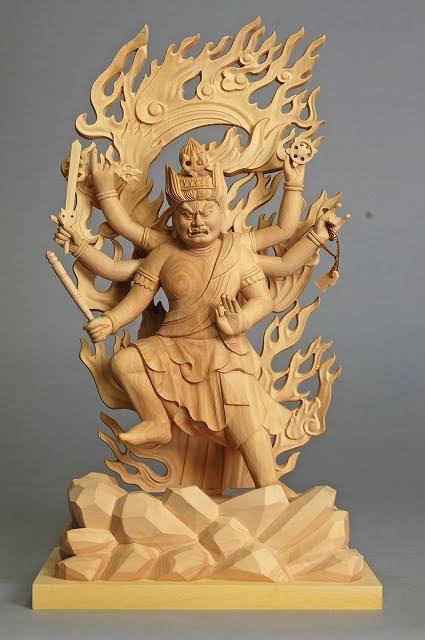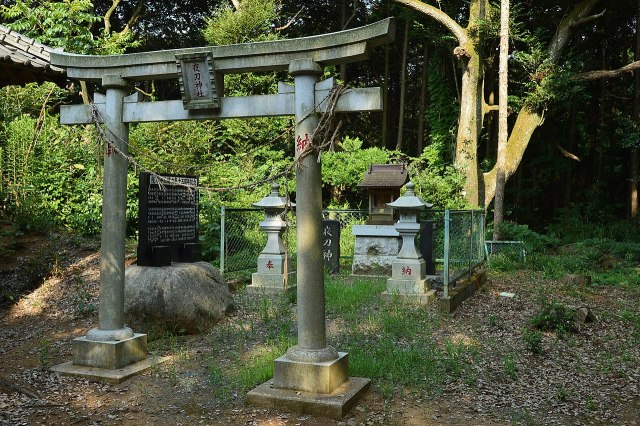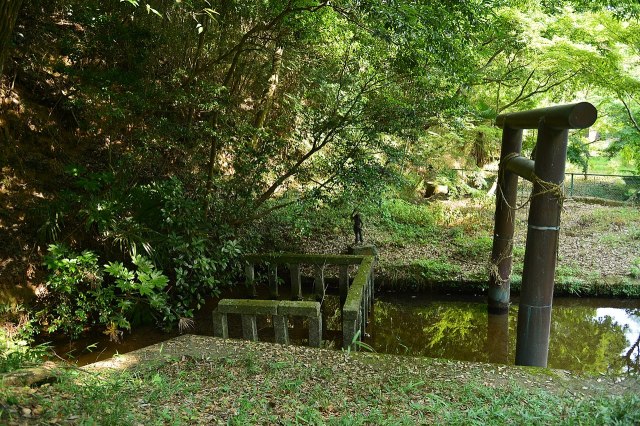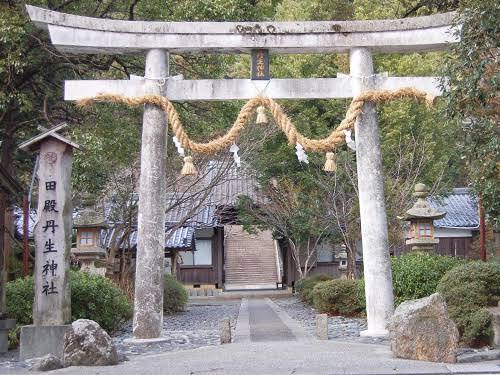#folkloblr
Who’re Benjogami?

It has been a hot minute since I posted Japanese folklore contents here, so, let’s gradually restart the trend!
Benjogami [便所神] also referred to as Sasugami [サス神] in Okayama Prefecture¹, Kanjogami [閑所神] in Miyagi Prefecture², or Kawayagami [厠神] in general³ are deities (usually a pair of male and female) of toilet mostly enshrined inside a restroom (like the ones above inside the restroom of Sendai City Museum of History and Folklore [仙台市歴史民俗資料館] in Miyagino Ward [宮城野区], Sendai City [仙台市], Miyagi Prefecture) and aside from being venerated due to their connection with securing hygiene via proper swage system³, their folkloric depictions are what inspired the creation of haunting entities in school restrooms from Japanese horror stories such as “Red Paper/Blue Paper” [赤い紙/青い紙] (plus other color variations).

Before we dive into contemporary stories, however, there are few notable features of Benjogami other than solely guarding restrooms. In places such as Ōta Ward [大田区] (Tōkyō), Benjogami are also related with child delivery believing that a family who keeps the restroom clean would be blessed with a good child as a result of appeasing Benjogami who would help the housewife during labor⁴. Another feature of Benjogami worth mentioning is how they’re conflated with Fudōmyō'ō [不動明王]/Acalanātha in many locations within Okayama Prefecture (e.g.: Maniwa City [真庭市])¹. Reasons to why this syncretism occured in Okayama Prefecture alone despite of Fudōmyō'ō not having anything to do with restrooms anywhere else are unclear. However, an educated guess can be made that another Buddhist deity called Ususama-myō'ō [烏枢沙摩明王]/Ucchuṣma (above) could’ve probably been replaced by Fudōmyō'ō due to the latter’s popularity in Japan and how they’re both Myō'ō [明王]/Vidyārāja with the key descriptive difference being that Ususama-myō'ō is traditionally considered as a deity who guard’s (via “purification”) restrooms in temples/monasteries⁵ just as Benjogami would. And now, for the spooky part!

Benjogami are generally feared. Like the belief² from Miyagi Prefecture tells, people would fall on their back and swoon from merely coming across these deities. Henceforth, such characteristics could’ve evolved over time and subsequently giving birth to “Gakkō-no-kaidan” [学校の怪談] (or “Haunting Tales From School”) style of entities like “Red Paper/Blue Paper” mentioned earlier because the most commonly endorsed color combination of red and blue in the said story is seen on traditional Benjogami idols (below) from Kanazawa City [金沢市] (Ishikawa Prefecture)⁶ as well; hinting to the possibility that the story in question could’ve theoretically be founded on Benjogami folklore. Folktales/beliefs of Benjogami as motif/reference in restroom related Japanese horror stories could also be observed during Edo Period such as with the story titled “Kurote-giri” [黒手切り] from modern day Ishikawa Prefecture. This story via “Shifugoroku” [四不語録] (Edo Period) by Yamai Asaka [浅香 山井] (n/a) told of a happening where the wife of a villager named Jingobē [甚五兵衛] reported her husband about how a disembodied hand caressed her butt cheek when she was using the restroom. I won’t go too much in depth here due to the rest of this story being off topic for now, but the point of me referencing it is because Benjogami are also reported to do something similar to unsuspecting people. Like in a legend⁷ from Koshigaya City [越谷市] (Saitama Prefecture), where Benjogami are said to scratch the butt cheek of people who tries to use the toilet at 6 PM.

It has been a while so I apologize for this subpar content, but there you have it!
Source:
1. “Okayamakenshi: Chapter 6 Minkan-shinkō-to-shūgendō…” [岡山県史: 第六章 民間信仰と修験道 第一節 屋敷神と屋内神: (二 屋内神)] (1983) by the Editorial Board of Okayama Prefecture’s History [岡山県史編纂委員会]
2. “Miyagikenshi Minzoku 3:…” [宮城縣史 民俗3: 妖怪変化・幽霊: 妖怪変化] (1956) by the Society of Miyagi Prefecture’s History (NPO) [財団法人宮城県史刊行会]
4. “Seikō-minzoku: Osan-ni-tachiau-kami…” [西郊民俗: お産に立ちあう神 東京都大田区の事例] (1982) by Keiko Nakashima [中島 恵子] (n/a)
5. “Mikkyō-no-seinaru-jumon” [密教の聖なる呪文] (2019) by Akira Masaki [正木 晃] (1953-present)
6.Via Doll Museum [人形ミュージアム] (official website)
7. “Tabi-to-densetsu:…” [旅と伝説: 埼玉県越ヶ谷地方の俗信] (1933) by Kentarō Fukushima [福島 憲太郎] (n/a)
What is the meaning of “compassion” embedded within the Lotus Sūtra?
Buddhist Parables (Chapter 1.): Migawari-jizō And The Great Compassion|能遮学侶|note
Buddhist parables from a famous Japanese folktale!
Please make sure to leave a comment and/or reblog with “Namu-myōhō-rengekyō” included!
Rain Making In Japanese Buddhism
Surprisingly, early records of rain making are mostly conducted by Buddhist monks rather than Shintō priests/priestesses. In “Tōdaiji-gusho” [東大寺具書] (Nara Period?), the very first Buddhist monk who performed rain dance was a monk from the Kingdom of Koryŏ [高麗/고려] by the name of Ekan [慧灌] (Asuka Period) who is the founder of Sanron Buddhist Sect [三論宗] in Japan¹. While his stay in Hōkō Temple [法興寺] (today’s Asuka Temple [飛鳥寺] (below) in Asuka Village [明日香村], Takaichi Dist. [高市郡], Nara Period) during the reign of Emperor Kōtoku [孝徳天皇], a series of draught struck Japan. This was when Ekan performed a rain making ritual as he recited verses from Sanron scriptures while wearing a blue dress which successfully brought rain.

Another less successful attempt was recorded from year 642 via “Nihon-shoki” when Empress Kyōgoku [皇極天皇] (594-661) instructed nobleman Soga-no-Emishi [蘇我 蝦夷] (586?-645) to conduct a rain making ritual on July 25th as he recited verses from Māhayāna Buddhist scriptures, but was instructed to desist after four days for the rain he managed to summon were mere drizzles and proper rain came only when the Empress prayed herself.
There’s also a legend² when two monks battled over who could bring down rain. In 1261, Shingon Buddhist Sect [真言律宗] monk Ninshō [忍性] (1217-1303) (below left) of Gokuraku Temple [極楽寺] (Kamakura City [鎌倉市], Kanagawa Prefecture) and another monk called Nichiren [日蓮] (below right) (1222-1282) who later founded Hokke Buddhist Sect [法華宗] fought each other to prove who’s teachings were superior. When Ninshō called upon the rain, it ended up summoning a tempest and failed, but delicate rain came down from the sky when Nichiren did the same; resulting to Nichiren taking the W.


Based upon these accounts, rain making became an integral part of Japanese Buddhist practice such as the manual for rain making together with drums and strawhats used in the ritual stored in Shindaibutsu Temple [新大仏寺] (Iga City [伊賀市], Mie Prefecture).
新大仏寺雨乞い関係文書 附 雨乞い踊り用具 文化遺産オンライン
This is especially true for Jōdoshin Buddhists [浄土真宗] with their Nenbutsu-odori [念仏踊] which is a Buddhist choreography of rain making practiced even to this day such as the famous Taki-no-miya-nenbutsu-odori [滝宮の念仏踊] performed in Ayagawa Town [綾川町] (Ayauta Dist. [綾歌郡], Kagawa Prefecture).
Sources:
Contingency Plan For Evil Kitsune
「九尾の狐」伝説の「殺生石」が真っ二つ…SNSでは「狐が復活しないといいけど」 : 社会 : ニュース
We got a disturbing report from Nasu Town [那須町] (Tochigi Prefecture) that Lady Tamamo-no-mae [玉藻前] might have escaped her detention since Late Heian Period, thanks to Onmyōdō Master Abe-no-Yasuchika’s [安倍 泰成] (1110-1183?) efforts, due to Sesshō-ishi [殺生石] splitting in half.
Protect yourself and your family by following these contingency plans:
Always carry a nail with you so she may not approach¹ and if shit hits the fan, just start smoking a cigarette because Kitsune hates the smell of burning tabacco². Stay safe out there.
(P.s.: This is clearly a joke. Pleased don’t put your health at risk by following any of the advices above.)
Source:
1. “Jōmin-bunka-kenkyū: Tama-no-mukashibanashi (2)…” [常民文化研究: 多摩の昔話 (二) 山間部及び平野部の補遺] (1983) by Akiko Masuda [増田 昭子] (n/a) & et al.
2. “Tabi-to-densetsu: Akitaken-senbokugun-jindaimura” [旅と伝説: 秋田県仙北郡神代村] (1933) by Tetsujō Mutō [武藤 鐡城] (1896-1956)
Coins In Summoning Ritual

Like the ten yen coin in Kokkuri-san [コックリさん] and other similar methods of seance popularized in urban legends (such as this one using a five yen coin to talk with ghosts, apparently), coins are considered as an essential tool in conducting such summoning rituals, but what does it have anything to do with communicating with ghosts/spirits? Truth is, certain kind of coins are believed to possess a deep connection with supernatural entities in the past which may explain their relation.

A belief¹ from Kita Dist. [喜多郡] (Ehime Prefecture) tells that if a person place one coin per one of six Rokujizō [六地蔵] (above) idols (i.e.: icons of Buddhist deity Jizō [地蔵] representing the six classes of beings or ṣaḍ-gati in Sanskrit²) at a temple’s cemetery, souls of the dead would exit from beneath their respective tomb. The coins used here are called Rokudōsen [六道銭] (below) which are six bronze coins offered inside caskets together with the corpse so that the deceased may use one coin whenever they travel through one of the six realms in the Afterlife after they cross the River of Sanzu [三途の川]³. Rokudōsen are also used as talisman in Tanabe City [田辺市] (Wakayama Prefecture) whenever a local dig up an old burial ground and by keeping some of the rusty coins inside a wallet/purse, it’s believed that Zeni-no-rei [銭の霊] or “spirits of coin” would look after the keeper by ensuring that they’ll always have spare changes in their pocket⁴.

Specific number of coins were also used as idols representing Funatama [船霊] or “ship deities” and this practice can be seen throughout Southwest Japan. For Kurahashi Island [倉橋島] (Kure City [呉市], Hiroshima Prefecture), Funatama is said to like gambling, so ship owners are said to enshrine eight Bunsen [文銭] (i.e.: coins issued in year 1668 which are the same currency with Rokudōsen) and a board for game of dice in their household⁵.

As an interesting sidenote, a tale⁶ from Nanbu Town [南部町] (Sanohe Dist. [三戸郡], Aomori Prefecture) tells of a shop owner who always got his money stollen from his shop by the vulpine spirit which he believed to have possessed the household next door. At one point, he even saw ten yen bills (below) (before they became coins in 1959) climbing up the pillar of his shop only to disappear into thin air. Could this story have inspired the usage of ten yen coin for Kokkuri-san?

Sources:
1. “Tabi-to-densetsu: Ehime-ken…” [旅と伝説: 愛媛県喜多郡蔵川] (1933) by Denmatsu Yokoda [横田 傳松] (n/a)
3.“”
4. “Tabi-to-densetsu: Wakayama-ken…” [旅と伝説: 和歌山県田辺町地方] (1933) by Teijirō Saiga [雑賀 貞次郎] (1884-1964)
5. “Minzoku: Aki-kurahashijima-no-hanashi” [民族: 安芸倉橋島の話] (1928) by Take Suga [管 多計] (n/a)
6. “San'in-minzoku: Kitsune-no-tsuita-hanashi 23” [山陰民俗: 狐の憑いた話二三] (1954) by Junjirō Koikawa [小井川 潤次郎] (1888-1974)
About Yatsu-no-kami

Yatsu-/Yato-no-kami [夜刀神] (above) are one of the many serpent deities in Japanese mythology. According to “Hitachi-no-kunifudoki” [常陸国風土記] (721), Yatsu-no-kami are said to be deities of snake with a pair of horn growing from their head that are native to today’s Rokkō area [鹿行地域] especially within Namegata City [行方市] (Ibaraki Prefecture). In the text, Yatsu-no-kami were fearsome deities that a person’s entire family would die out just from looking at them, but it turned out that this wasn’t the case for the two characters in this legend who promptly defeated them.
First was Yahazu-no-Matachi [箭括 麻多智] (circa 6th century AC) (below) who was the noble of ancient Namegata that established new rice fields in the West through reclamation of the plateau near the valley. Yatsu-no-kami didn’t approve of this landscaping project and began harassing Matachi. Angered, he armed himself with a stick and armor then charged towards Yatsu-no-kami. As Matachi literally beat the serpent deities into retreat, he drove the same stick he used as weapon through a mound to mark the boundary separating Yatsu-no-kami’s and human’s domain at the entrance of Mt. Tenryū [天龍山] saying: “Anywhere beyond this point is your territory while anywhere before where I stand is our territory for humans. For we shall venerate and worship you forever, I ask you all to not seek vengeance and harm us.”

Alas, Matachi successfully established an approx. twenty-four acres large rice field and a shrine was built to honor Yatsu-no-kami which is today’s Tenryūzan-atago Shrine [天龍山愛宕神社] (below) in Namegata City. This confrontation with Yatsu-no-kami, however, didn’t end with Matachi.

After many years later, another noble by the name of Mibu-no-Maro [壬生 麻呂] (circa Mid. 7th century AC) came to rule Hitachi-no-kuni [常陸国] (modern day most of Ibaraki Prefecture) as a statecraft ruler dispatched by Emperor Kōtoku [孝徳天皇] thus, Matachi’s rice fields and the land around it naturally became his property. There, Maro launched a project to construct an embarkment to better manage the water flow in the valley. Though the Yatsu-no-kami yet again disrupted the construction by loitering around the pond where the water for the rice fields was stored as they relaxed on the nearby chinquapin tree branches. After patiently waiting for them to leave, Maro finally had enough and shouted: “I’m trying to reconstruct this pond in order to improve the life of local people. Just what sort of deities refuses to obey the command of Imperial mandate?” Seeing that Yatsu-no-kami ignored his complaints, Maro summoned his subordinates and instructed: “Go through every grass and bushes and kill all creatures that dwells within.” Alas, Yatsu-no-kami were driven out from the pond and went to hiding. The pond that was then managed by Maro later came to be known as Shi'ii-no-ike [椎井池] which is today’s Tenryū-no-mitarashi [天龍の御手洗] (below) located within Tenryūzan-atago Shrine.

So what is the message that this legend of Yatsu-no-kami from “Hitachi-no-kunifudoki” trying to communicate? First of all, we know that these serpent deities were the lords of the valley within Mt. Tenryū because the word “yatsu” means “valley” in old East Japanese dialect¹, but why did Matachi venerate them while Maro didn’t? This is argued to be because the interaction between Matachi and Yatsu-no-kami in the legend was a metaphor of humanity overcoming the hardship placed by Nature where Matachi (as humanity) subdued Yatsu-no-kami (as Nature) by bringing the land under his control to exploit, but still recognized the volatile characteristics of Nature thus, attempted on comforting by enshrining the deities as a sign of respect and admiration². Where else for Maro, he only came to rule the place as that was his bureaucratic duty which made Yatsu-no-kami a nuisance that got in his way of fulfilling the divine Emperor’s request who was far more supreme than some minor, local deity and this attitude is also reflected in what Maro said to Yatsu-no-kami when he first confronted them unlike Matachi’s final speech².
Another notable feature in this legend is how a stick was used to mark boundaries which is something seen in other Japanese legends. This stick is technically known as Imizue [忌杖] and it also appears in the origin legend of Tadononyū Shrine [田殿丹生神社] (below) (Aridagawa Town [有田川町], Arida Dist. [有田郡], Wakayama Prefecture) where Nifutsuhime-no-mikoto [丹生都比売命] installed four sticks at the corners to mark the sanctuary of where the shrine stands today and began the process of reclamation from there³ just as Matachi split the land between Yatsu-no-kami and human.

Sources:
1. “Kyōkai-no-hassei” [境界の発生] (2002) by Norio Akasaka [赤坂 憲雄] (1953-present)
2. “Bushi-no-genzō…” [武士の原像: 都大路の暗殺者たち] (2020) by Yukihiko Seki [関 幸彦] (1952-present)
